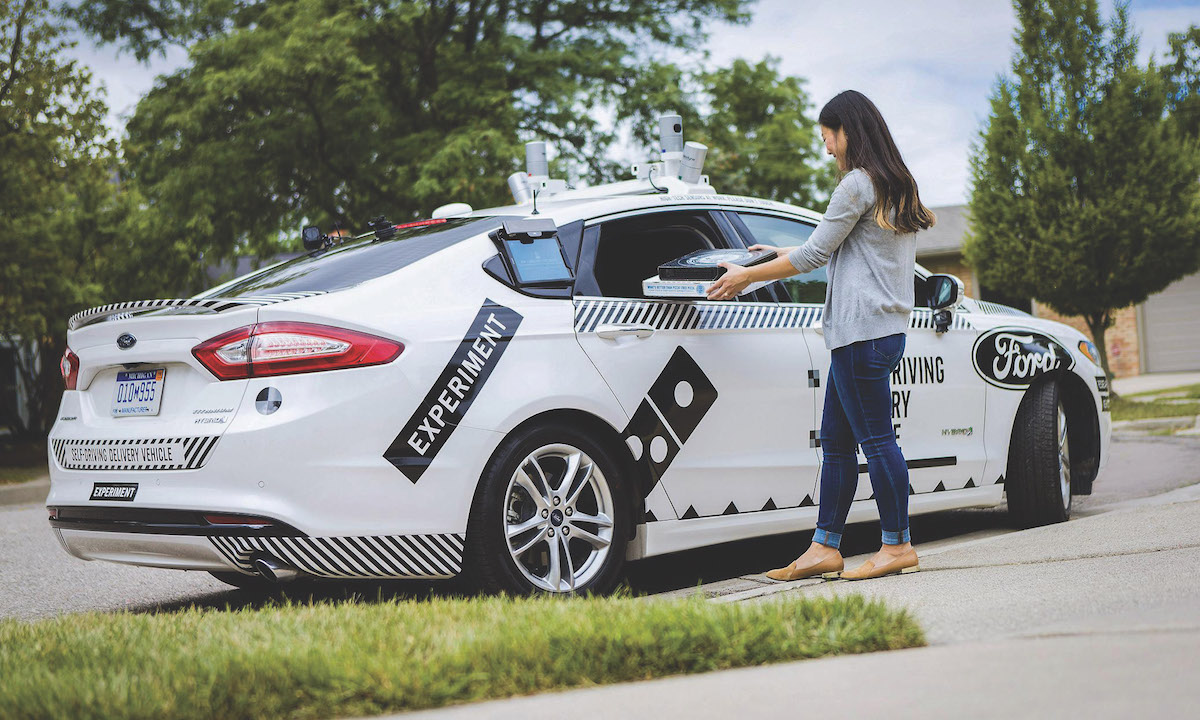While trains, trucks and ships continue the global movement of our food in what is now a decades-old system, the evolution of that last mile to our front door is vaulting forward. Here are a few innovations that might become old hat within the next few years.
Foodie Robots
 Don’t be surprised when you begin to notice your sidewalk cluttered with electronics instead of people. DoorDash, an on-demand food delivery service based in San Francisco, is testing out robots as an addition to its food-delivery workforce. [Read more about DoorDash in our story, “Smarter TV Dinners.”] With pilot programs that began in Redwood City in 2017, the self-driving robots deliver goods to customers within a two-mile radius. The futuristic helpers come from Starship Technologies and look like small refrigerators on wheels. The self-guided machines use nine cameras and sound waves to create an imaginary bubble around them, which allows them to go around objects or make a full stop. It’s not all rose-colored glasses, though, as cities like San Francisco attempt to enact restrictions limiting these pesky bots.
Don’t be surprised when you begin to notice your sidewalk cluttered with electronics instead of people. DoorDash, an on-demand food delivery service based in San Francisco, is testing out robots as an addition to its food-delivery workforce. [Read more about DoorDash in our story, “Smarter TV Dinners.”] With pilot programs that began in Redwood City in 2017, the self-driving robots deliver goods to customers within a two-mile radius. The futuristic helpers come from Starship Technologies and look like small refrigerators on wheels. The self-guided machines use nine cameras and sound waves to create an imaginary bubble around them, which allows them to go around objects or make a full stop. It’s not all rose-colored glasses, though, as cities like San Francisco attempt to enact restrictions limiting these pesky bots.

Edible Drones
The future of delivery, according to everyone, is drones. But that reality — drones dropping boxes out of the air — is a long way off, despite stunts pulled off by Google and Amazon. However, two designs are delivering food in meaningful ways. Windhorse Aerospace has developed a one-use drone, nicknamed Pouncer, to bring food and other supplies to disaster zones. The device, made of lightweight plywood that can be used for firewood post-delivery, incorporates meals wrapped in thin plastic that could be reused in disaster shelters once the meals are finished. According to founder Nigel Gifford (above), the drone will feed about 100 people for one day. Inedible components, such as the electronics, are being kept to a minimum. One day, Gifford’s crafty engineers could wrap those components in bouillon cubes. Sounds delicious, right?
Another forward-thinking drone test is happening in our national parks. The pilot program is aimed at rescuing prairie dogs. The cute rodents have been hit by a disease that, if left untreated, could spell disaster for their primary predator, the black-footed ferret, an animal on the brink of extinction. This is where the drones come in: They’re dropping peanut-butter pellets — the size of blueberries — laced with vaccine for the sick prairie dogs on the ground. The beauty of the drones in both examples is the distance they can cover and their ability to serve hard-to-reach spots.

Autonomous Pizza
For six weeks in late 2017, Ford partnered with Domino’s to deliver pizzas to randomly selected customers in Ann Arbor, Michigan, via its Ford Fusion Hybrid Autonomous Research Vehicle. Customers who agreed to be a part of the test could track their pizza on the Domino’s delivery app, receiving text messages as the car approached. When it arrived, customers received a text with a unique code to unlock the heating compartment inside the vehicle and retrieve their pizza. Ford’s test cars use lidar, a method for measuring distance to a target using pulsed laser light detected by both radar and camera sensors. While the test did include an engineer behind the wheel, the windows were blacked out so there was no interaction. Despite these depersonalization measures, the team found people wanted to interact with the car, even saying hello to it and waving goodbye. As the second-most-profitable pizza company in the world, behind Pizza Hut, Domino’s is paying close attention to what role self-driving vehicles may play in the future. While Ford won’t begin building its self-driving vehicles until 2021, you can already order a pie from Domino’s simply by tweeting the pizza emoji to your local franchise. [Read more about the self-driving Domino’s vehicles in MIT’s Technology Review.]

Underground Delivery
In the distant future we may see the return of pneumatic tubes making their way back into the world as we know it. Several years ago, Amazon filed for a patent for a dedicated system of underground tunnels that could bring packages closer to home — a system that “may avoid congestion experienced by traditional transportation networks.” Late in 2016, the patent was awarded. Other companies are tinkering with similar ideas: Elon Musk is developing technology to bore tunnels below street level in Los Angeles, and Mole Solutions Ltd, an English company, has tested similar systems with government funding. But there’s another more obvious use for our underground spaces, and that’s for our salad bowl. So far, we’ve got greens growing inside giant warehouses, in shipping containers and on rooftops, and it won’t be long before we see hydroponic cells — microfarms, if you will — cropping up underground. When the lettuce is ready for harvest, it can be delivered quickly to surrounding areas, keeping the carbon footprint as tiny as a microgreen.

Author
Larissa Zimberoff is a freelance writer covering the intersection of food and technology. Although she’s lived in New York for over six years she has never had food delivered to her rent-stabilized apartment.